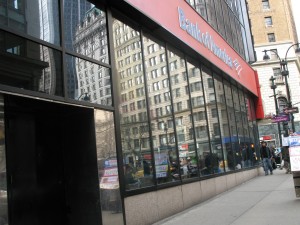Fed Says Fewer Banks Eases Last Quarter Business-Loan Terms
Post Views 0
The banks were slightly more likely to ease than tighten down on their standards on credit, ”in contrast to more widespread reports of such easing in previous quarters,” Said the central bank today in its quarterly survey of senior loan officers. Banks that went to raise their standards ”cited a less favorable or more certain economic outlook as a reason for the tightening.”
Fed Chairman Ben S. Bernanke and his colleagues on the Federal Open Market Committee have struggling to boost this economy that is so weak that unemployment has been near 9 percent or higher for 31 consecutive months. Last week in a press conference, Bernanke said that the expansion is hampered by ”still-tight credit conditions” for many households and small businesses and that ”monetary policy has been blunted” by the severely dysfunctional mortgage market.
About half of U.S. banks said they made loans or extended credit lines to European counterparts, in a special set of questions on lending to firms with European exposure. About two-thirds of all of the banks that made some kind of loan to European banks tightened their standards, and many of them ”indicated that the tightening was considerable.”
In the third quarter, the U.S. economic growth quickened to a 2.5 percent annual rate after a 0.4 percent pace in the first quarter and 1.3 percent in the second. In October, employers added 80,000 employees to their payrolls, and the unemployment rate unexpectedly dipped to 9 percent.
The Fed said that a survey of loan officers at 51 domestic banks and 22 U.S. branched and agencies of foreign banks. was conducted from October 4th or 18th. The report does not identify respondents.
”This was taken over a period when there was intense uncertainty about where the U.S. and world economy was headed,” says Millan Mulraine, who is the senior U.S. strategist at TD Securities in New York. ”You would fold your wings when you’re not certain about where things are headed, so this report, while disappointing, should be seen as mostly transitory.”
In October, the Standard &Poor’s 500 Index advanced 11 percent, the best it’s advanced since 1991, as European leaders agreed to expand their bailout fund. The rally snapped five months worth of losses.
U.S. stocks rose following the report, only after the European Central Bank’s Juergen Stark has said region’s debt crisis will be under their control in years at the latest. As of 2:55 p.m. in New York, the S&P 500 was up 0.3 percent at 1,256.77. The yield on the long 10-year treasury, declined 4 basic points to 1.99 percent. With the basic point being 0.01 percentage point.
”We continue to see a solid performance in our commercial and corporate lending businesses,” Brian Moynihan, the bank’s chief executive, said in an Oct. 18 earnings call. ”Our credit quality and delinquencies continue to improve, while reserve remains at high levels.”
Fed Says Fewer Banks Eases Last Quarter Business-Loan Terms by Harrison Barnes


 Top Canadian Companies You Want to Work For
Top Canadian Companies You Want to Work For  2006-2015 Median Weekly Earnings of Full-Time Workers in the United States
2006-2015 Median Weekly Earnings of Full-Time Workers in the United States  US Dollar Gaining Momentum
US Dollar Gaining Momentum  Amazon May Have a Better Grasp on Workplace Culture
Amazon May Have a Better Grasp on Workplace Culture  Chicago’s Top Tech Companies
Chicago’s Top Tech Companies  November Posts Another Strong Job Report
November Posts Another Strong Job Report  Expected Changes in 2016 to the Workplace
Expected Changes in 2016 to the Workplace